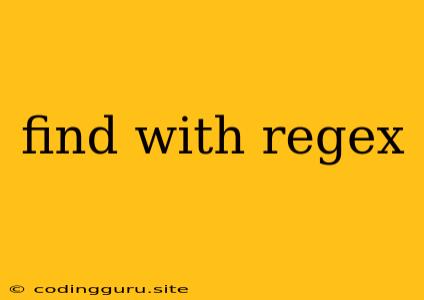Find with Regex: Mastering the Art of Pattern Matching
Regular expressions, often shortened to regex, are powerful tools used to search, match, and manipulate text based on specific patterns. They are widely used in programming languages, text editors, and even command-line tools. Understanding and applying regex opens up a world of possibilities for data manipulation and analysis.
So, how do you use regex to find what you need?
The key is to create a pattern that describes the target text you're searching for. This pattern is written using a specific syntax, which can vary slightly depending on the tool or language you're using.
The Basics of Regex Patterns
Let's break down some essential elements of regex patterns:
- Characters: Most characters in a regex pattern match themselves literally. For example, "cat" will match the word "cat" in the text.
- Special Characters: Certain characters have special meanings in regex. For instance, a dot (.) matches any single character.
- Quantifiers: These symbols specify how many times a preceding character or group should appear.
*(star): Matches zero or more occurrences.+(plus): Matches one or more occurrences.?(question mark): Matches zero or one occurrence.{n}: Matches exactlynoccurrences.{n,}: Matches at leastnoccurrences.{n,m}: Matches betweennandmoccurrences.
- Character Classes: These are special symbols that represent groups of characters:
\d: Matches any digit (0-9).\s: Matches any whitespace character (space, tab, newline).\w: Matches any alphanumeric character (a-z, A-Z, 0-9, underscore).
- Anchors: These characters specify positions within the text:
^: Matches the beginning of the string.$: Matches the end of the string.
- Grouping and Alternation:
( ): Groups characters together for applying quantifiers or alternation.|(pipe): Matches either the expression before or after the pipe.
Example: Finding Email Addresses
Let's say we want to find all email addresses in a block of text. A simple regex pattern for this could be:
[a-zA-Z0-9._%+-]+@[a-zA-Z0-9.-]+\.[a-zA-Z]{2,}$
Let's break it down:
[a-zA-Z0-9._%+-]+: Matches one or more alphanumeric characters, periods, underscores, percent signs, plus signs, hyphens, or underscores before the "@" symbol. This represents the username part of the email.@: Matches the "@" symbol.[a-zA-Z0-9.-]+: Matches one or more alphanumeric characters, periods, or hyphens after the "@" symbol. This represents the domain name.\.[a-zA-Z]{2,}$: Matches a period followed by two or more letters, representing the top-level domain (e.g., .com, .net, .org).
Tips for Successful Regex Hunting
- Start Simple: Begin with a basic pattern and gradually refine it as needed.
- Test Regularly: Use online regex testers or your chosen language's debugging tools to verify that your pattern is working as intended.
- Understand Your Data: Analyze the structure of the text you're searching to create a pattern that accurately captures the elements you're interested in.
- Use Online Resources: There are numerous online tools and tutorials to help you learn and practice regex.
- Be Specific: Tailor your pattern to match the exact elements you want to find.
Beyond Finding: Utilizing Regex for Transformation
Regex is not limited to simply finding text. You can also use it to:
- Replace: Substitute matched patterns with different text.
- Extract: Isolate specific parts of the matched text.
- Validate: Check if a string conforms to a particular pattern.
For example, you could use regex to automatically format phone numbers, extract specific data from a log file, or verify that a password meets certain criteria.
Conclusion
Regex is an incredibly powerful tool for text manipulation and analysis. Learning to use it effectively can significantly enhance your ability to process and work with data. By mastering the basic elements of regex patterns and practicing with different use cases, you'll gain a valuable skill that can streamline your workflow and solve a wide range of challenges.
